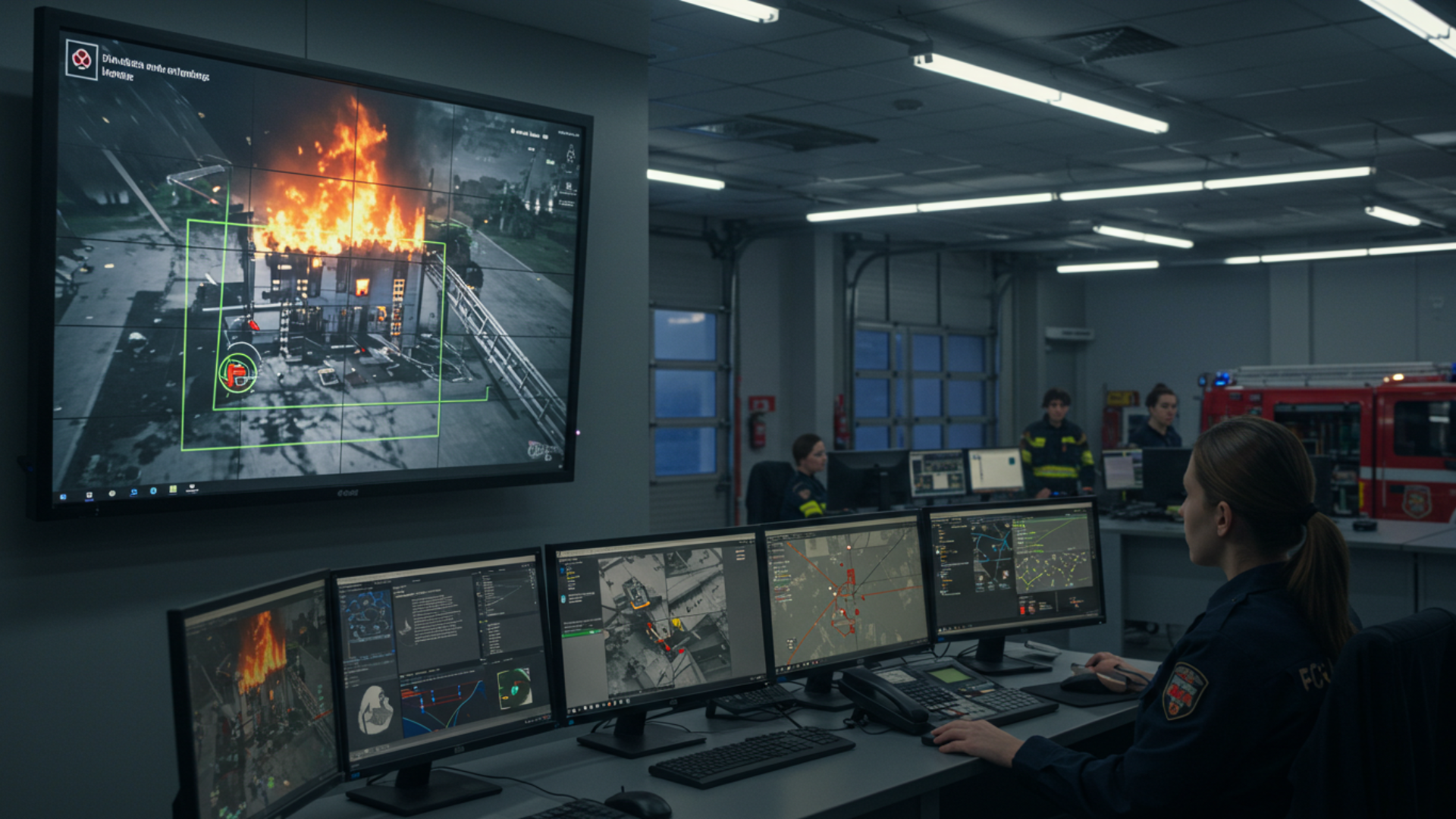Respond Swiftly to Potential Fire Hazards with Anomaly Detection
by Sarim Suleman, Last updated: November 19, 2025, Code:

Anomaly detection systems help fire departments respond faster and more effectively to potential hazards. By leveraging AI and real-time analytics, these tools improve safety, reduce false alarms, and protect lives and property. Learn how investing in these technologies is crucial for fire departments facing rising fire risks.
Fire departments are at the forefront of protecting lives, property, and natural ecosystems from fire hazards. Yet, traditional fire detection systems often fail to address critical gaps in monitoring and responding to risks, particularly in fire-prone areas or densely populated public spaces. Delayed detection of hazards like illegal burning, unattended flammable materials, or sudden temperature spikes can lead to catastrophic outcomes.
This is where anomaly detection for fire departments provides an essential upgrade. Using technologies like machine learning algorithms, and real-time analytics, anomaly detection systems monitor fire-prone zones, industrial sites, and public areas to identify irregularities that signal potential dangers. These systems deliver automated alerts, allowing fire departments to respond quickly and effectively to mitigate risks.
By integrating smoke and fire detection in public areas, anomaly detection tools not only improve safety but also reduce false alarms and streamline operations. Whether it’s detecting illegal burning in rural areas or spotting smoke emissions in urban centers, this technology empowers fire departments to act swiftly and decisively.
In this blog, we’ll discuss how anomaly detection for fire departments addresses these challenges, explore its real-world applications, and examine its transformative role in modern firefighting. From preventing hazards to enabling faster responses, this technology is a vital resource for fire departments looking to enhance public safety.
The Growing Need for Advanced Fire Detection Systems
In recent years, both urban and rural areas have witnessed a significant increase in fire incidents, underscoring the urgent need for advanced fire detection systems. For instance, the 2025 wildfires in Los Angeles scorched nearly 63 square miles of densely populated areas—the largest urban area affected by fires in California in at least 40 years.
These fires resulted in at least 27 fatalities, destroyed over 13,600 structures, and forced roughly tens of thousands to evacuate. Experts attribute this rise in urban fires to factors such as climate change and the expansion of urban areas into wildland regions.
Fire departments face several challenges in effectively monitoring and responding to these increasing fire hazards:
- Limited Resources: Monitoring vast fire-prone areas requires substantial manpower and equipment. Many departments lack the necessary resources to maintain constant vigilance over these regions, leading to delayed responses when fires break out.
- Delayed Detection of Hazards: Activities like illegal burning or the presence of unattended flammable materials can quickly escalate into uncontrolled fires if not promptly identified. Traditional detection methods often fail to catch these hazards in time, resulting in devastating consequences. For example, a bushfire on K'gari's Eastern Beach in 2024, allegedly caused by an illegal campfire, burned approximately 280 hectares before being contained.
- Inefficiencies in Traditional Detection Systems: Conventional smoke and fire detection systems, especially in public areas, may not provide real-time alerts or cover extensive outdoor environments effectively. This limitation hampers the ability of fire departments to respond swiftly to emerging threats.
Given these challenges, the importance of proactive hazard detection cannot be overstated. Implementing advanced fire detection systems that leverage technologies such as anomaly detection for fire departments can significantly enhance the capabilities of fire departments. By providing real-time monitoring and early warning signals, these systems enable quicker responses, thereby mitigating damage, saving lives, and preserving property.
What Is Anomaly Detection for Fire Departments and How Does it Work?
Anomaly detection is an advanced AI-driven technology that identifies unusual patterns or deviations in data to predict and prevent potential hazards. Anomaly detection for fire departments monitors environmental factors to detect risks before they escalate into fires. By leveraging cutting-edge AI technologies like machine learning algorithms and real-time analytics, anomaly detection systems empower fire departments to respond proactively to threats, enhancing both efficiency and safety.
Key Technologies Powering Anomaly Detection for Fire Departments
Anomaly detection systems rely on a combination of advanced technologies to monitor fire-prone areas and public spaces effectively. From IoT sensors capturing real-time environmental data to AI-driven analytics identifying potential hazards, these tools enable fire departments to act swiftly and prevent disasters. Here’s a closer look at the technologies that are making this possible.
1. Video Surveillance: Monitoring and Detecting Suspicious Activities
Video surveillance systems form a critical part of anomaly detection, especially when it comes to identifying suspicious activities in public spaces or fire-prone areas. These systems continuously capture real-time footage, allowing fire departments and security teams to monitor large areas efficiently and respond to potential threats before they escalate.
- Monitoring Suspicious Activities: Video surveillance cameras can detect unusual behavior or unauthorized activities, such as illegal burning, rising smoke, or the presence of unattended hazardous materials. By leveraging advanced video analytics, suspicious activities can be flagged automatically, enabling quicker intervention.
- Real-Time Alerts and Data Analysis: With video surveillance integrated into anomaly detection systems, alerts are generated in real-time when an abnormal situation is detected. This allows responders to act quickly and address any potential risks, such as fires starting from discarded flammable materials or illegal activities in public spaces.
By incorporating machine learning algorithms into video surveillance systems, fire departments, and security teams can ensure more accurate monitoring and quicker identification of risks, ultimately improving response times and safety in high-risk areas.
2. Machine Learning Algorithms: The Brain Behind Anomaly Detection
Machine learning (ML), a subset of AI, serves as the core technology that identifies patterns and deviations indicative of fire hazards. By analyzing large datasets, ML algorithms enable anomaly detection systems to discern between normal environmental conditions and potential threats, such as fires.
- Pattern Recognition: Machine learning models are trained on historical data to recognize normal environmental behaviors, such as typical temperature fluctuations, air quality ranges, or expected humidity levels for specific regions. These models excel at identifying fire-prone areas and help fire departments continuously monitor them to prevent future incidents.
- Anomaly Detection: When new data deviates from these established norms—such as rising smoke, flammable objects, or the appearance of unusual smoke patterns—machine learning models flag these anomalies as potential fire hazards. The system immediately prioritizes these flagged anomalies, alerting fire departments to investigate further.
- Continuous Learning: One of the key benefits of machine learning is its ability to continuously learn from new data and past incidents, improving over time. As the system receives more data, the algorithm refines its models, making the system more accurate and effective in detecting actual threats.
This AI-driven approach ensures that fire departments receive actionable insights with minimal disruptions caused by false alarms. An example of a real-world application of such machine learning models can be seen in California's use of AI-powered detection of growing wildfires. The AI program was trained to detect smoke and early fire signs using feeds from over 1,050 forest cameras across the state. The system instantly alerts local fire departments via text when it spots potential fires. In just two months, it accurately identified 77 fires before any 911 calls were made.
By utilizing machine learning, fire departments can ensure a higher level of precision in detecting fire hazards, ultimately improving both safety and operational efficiency.
3. Real-Time Analytics: The Decision-Making Power of AI
Real-time analytics, powered by AI, processes incoming data instantaneously to deliver actionable insights. This ensures fire departments can act immediately when an anomaly is detected.
- Automated Alerts: AI systems generate instant notifications, detailing the location, severity, and nature of the anomaly. Alerts are sent to fire department teams via mobile devices, control centers, or integrated platforms.
- Threat Prioritization: AI evaluates the severity of detected anomalies, allowing fire departments to prioritize responses to the most critical threats.
By transforming raw data into meaningful insights, real-time analytics driven by AI enhances the speed and precision of fire safety responses.
How Anomaly Detection for Fire Departments Identifies Irregularities
Anomaly detection systems are highly effective at identifying irregularities in both natural and urban settings, enabling fire departments to address potential hazards before they escalate. When anomalies, such as smoke in unpopulated areas, are detected, they are flagged for immediate investigation.
In urban environments, anomaly detection systems play a crucial role in ensuring public safety by monitoring crowded spaces like parks, transit hubs, and stadiums for signs of smoke or flammable objects.
By combining real-time monitoring and automated alerts, anomaly detection systems help fire departments mitigate risks in both rural and urban settings effectively.
Benefits of Anomaly Detection for Fire Departments
Implementing anomaly detection for fire departments offers numerous advantages, transforming how hazards are identified, prioritized, and addressed. These benefits not only enhance fire safety but also improve overall operational efficiency and cost-effectiveness.
- Faster Response Times: Real-time monitoring systems equipped with anomaly detection enable automated alerts that provide precise hazard identification and location details. Firefighters receive actionable insights within seconds, reducing response times and minimizing damage. This is illustrated in northwest Tasmania, where an AI-powered bushfire detection system has been installed to enhance fire detection and improve response times.
- Enhanced Safety: Early detection through anomaly detection protects civilians by mitigating risks before they escalate. It also safeguards first responders by allowing informed decision-making and reducing exposure to dangerous situations.
- Operational Efficiency: By significantly reducing false alarms, anomaly detection conserves valuable resources, enabling fire departments to focus on genuine threats. The technology allows teams to allocate personnel and equipment more strategically, optimizing overall operations.
- Cost Savings: Preventing fires through early detection minimizes property damage, lowers firefighting expenses, and reduces the long-term economic impact of fire incidents. This proactive approach leads to considerable financial benefits for municipalities and organizations.
- Environmental Protection: Anomaly detection systems play a crucial role in mitigating the spread of wildfires, which are a significant contributor to deforestation and air pollution. By addressing fire hazards early, these systems help protect natural ecosystems and reduce environmental damage.
Why Fire Departments Should Invest in Anomaly Detection Now
As fire risks become increasingly unpredictable due to climate change, urban sprawl, and industrial expansion, adopting anomaly detection for fire departments is no longer optional—it is essential. Below, we discuss why anomaly detection for fire departments should be implemented.
Rising Fire Risks
The escalating frequency and severity of wildfires underscore the urgent need for advanced fire detection technologies. Recent studies indicate that extreme wildfires have more than doubled in frequency and intensity over the past two decades, particularly in regions like North America and Russia. The wildfire season has lengthened in the United States due to warmer springs, extended summer dry periods, and drier soils and vegetation. This trend is expected to continue, with climate change projected to increase the frequency, extent, and severity of fires through higher temperatures and prolonged drought conditions. Fire departments need advanced tools, such as anomaly detection systems, to respond to these increasing threats and protect communities.
Urban Sprawl Exacerbates Fire Risks
As cities continue to expand into previously undeveloped lands prone to wildfires, the wildland-urban interface (WUI) has significantly grown. This expansion increases the potential for fire incidents to impact densely populated areas and critical infrastructure. As more people move into high-risk zones, the threat of catastrophic fires becomes more pronounced. This urban sprawl, combined with fire risks, further emphasizes the need for fire departments to adopt proactive monitoring systems like anomaly detection to detect fires early, respond faster, and mitigate potential damage.
Economic and Social Benefits of Investing in Anomaly Detection
Investing in anomaly detection equips fire departments with the necessary tools to stay ahead of evolving fire risks, safeguard communities, and ensure a quicker, more effective response to fire incidents. Additionally, proactive investments in fire detection technologies provide significant economic benefits. By reducing property damage, healthcare costs, and environmental restoration expenses caused by large-scale fires, fire departments can help mitigate the financial burden on local governments and communities.
Conclusion: A Safer Future with Anomaly Detection for Fire Departments
Anomaly detection is revolutionizing fire safety by providing fire departments with the tools they need to monitor fire-prone areas, detect hazards early, and respond swiftly to potential risks. By leveraging technologies like AI, machine learning, and real-time analytics, these systems enhance response times, improve safety, and reduce environmental and financial impacts.
As fire risks continue to evolve, adopting anomaly detection for fire departments is a vital step toward proactive fire safety management. By integrating this transformative technology, fire departments can protect lives, property, and the environment more effectively than ever before. Now is the time to embrace this innovation and secure a safer future for our communities.
People Also Ask
What is anomaly detection in fire safety?
Anomaly detection in fire safety refers to the use of advanced technologies, including AI, machine learning, and predictive analytics, to identify unusual patterns or deviations in data that may indicate a potential fire hazard. This enables fire departments to detect threats before they escalate into major incidents.
How does anomaly detection help fire departments respond to fires more quickly?
Anomaly detection systems provide real-time monitoring and automated alerts, allowing fire departments to respond faster. By identifying unusual smoke, flammable objects or any other unusual activity, these systems ensure fire departments are alerted immediately to potential risks, reducing response times and minimizing damage.
How do machine learning algorithms improve fire detection?
Machine learning algorithms process large datasets from sensors and video surveillance, identifying patterns of normal behavior and flagging deviations that indicate a fire risk. These algorithms continuously learn from new data, improving the system's accuracy.
What role does video surveillance play in anomaly detection for fire departments?
Video surveillance systems are integrated with anomaly detection to monitor suspicious activities, such as illegal burning or the presence of unattended hazardous materials. Advanced video analytics can automatically flag these activities, allowing fire departments to intervene quickly and reduce the risk of fire outbreaks.
How is anomaly detection used in urban areas?
In urban settings, anomaly detection systems monitor public spaces like parks, transit hubs, and stadiums for unusual smoke or flammable objects. If an anomaly is detected, the system triggers real-time alerts, allowing fire departments to act quickly to mitigate potential risks before they escalate.
Are anomaly detection systems scalable for small fire departments?
Yes, anomaly detection systems are scalable and can be customized to meet the needs of both small and large fire departments. These systems can be adapted to monitor a small urban area or large rural regions, making them flexible for various fire department sizes and locations.
What are the economic benefits of investing in anomaly detection for fire departments?
Investing in anomaly detection can lead to significant cost savings by reducing property damage, minimizing firefighting expenses, and preventing costly environmental restoration after large-scale fires. Proactive detection helps avoid large-scale incidents that would otherwise result in heavy financial burdens on communities.
How does machine learning improve anomaly detection over time?
Machine learning models improve over time by continuously analyzing new data from real-time sensors and historical incidents. As the system collects more data, it refines its predictions, increasing its accuracy in detecting potential fire hazards and reducing false positives.
Jump to
You May Also Like
These Related Stories

How AI-powered Anomaly Detection Helps Organizations Stay Secure and Compliant

Anomaly Detection in Modern Electoral Systems


No Comments Yet
Let us know what you think